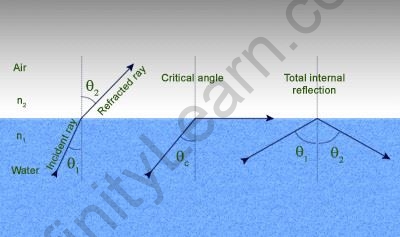Table of Contents
Total internal reflection (TIR) is an optical phenomenon in which waves arriving at the interface (boundary) of one medium to another (e.g., water to air) are completely reflected back into the first (“internal”) medium rather than refracted into the second (“external”) medium.
How does it happen ?
It happens when the second medium has a faster wave speed (lower refractive index) than the first and the waves strike the interface at an oblique angle. When viewed obliquely from below, the water-to-air surface in a typical fish tank, for example, reflects the underwater scene like a mirror with no loss of brightness.
TIR occurs not only with electromagnetic waves like light and microwaves but also with sound and water waves. If the waves are able to form a narrow beam, the reflection is usually described in terms of “rays” rather than waves; in a medium with directionless properties, such as air, water, or glass, the “rays” are perpendicular to the associated wave fronts.
In most cases, refraction is accompanied by partial reflection. When waves are refracted from a medium with a lower propagation speed (higher refractive index) to a medium with a higher propagation speed
For example, from water to air—the angle of refraction is greater than the angle of incidence (between the incoming ray and the normal).
- The angle of refraction approaches 90° as the angle of incidence approaches a certain threshold, known as the critical angle, at which the refracted ray becomes parallel to the boundary surface.
- As the angle of incidence approaches the critical angle, the conditions of refraction can no longer be satisfied, resulting in no refracted ray and total reflection.

Overview
When the incidence angle exceeds a predetermined limiting angle, known as the critical angle, the effect occurs. When a light ray strikes an interface, it is reflected and/or refracted.
- A light ray travels from a water medium to an air medium and vice versa. At the interface that separates the two media, light rays will be refracted.
- As it moves from a medium with a higher refractive index to one with a lower refractive index, the refracted light ray bends away from the normal.
- The incident ray of light is refracted so that it passes down the surface of the water at a specific angle of incidence known as the critical angle.
- If the angle of incidence is greater than the critical angle, the refraction angle is now 90 degrees, and incident light can reflect on the medium. As a result, this phenomenon is a complete internal reflection.
Total internal reflection, in physics, the complete reflection of a ray of light from the surrounding surfaces back into a medium such as water or glass.
- The phenomenon occurs when the angle of incidence exceeds a certain limiting angle known as the critical angle.
- Total internal reflection occurs at the boundary between two transparent media when a ray of light in one medium approaches the other medium at an angle of incidence greater than the critical angle.
- Because refraction indices vary with wavelength, the critical angle (and thus the angle of total internal reflection) will vary slightly with wavelength and, thus, with colour.
- Both refraction and reflection occur in varying proportions at all angles less than the critical angle.

JEE Foundation Class for 9
JEE Foundation Class for 9 enhances critical thinking and problem-solving skills through engaging activities and advanced learning techniques, ensuring academic excellence.
Examples of Total Internal Reflection
When the incident ray strikes every face of a diamond, the angle formed by the ray is greater than the critical angle. The diamond’s critical value is 23°. This condition is responsible for a diamond’s total internal reflection, which makes it shine.
Mirage: An optical illusion that causes the appearance of a water layer at short distances in a desert or on a road. Mirage is a type of total internal reflection caused by atmospheric refraction.
Optical fibre: When an incident ray strikes the cladding, total internal reflection occurs because the angle formed by the ray is greater than the critical angle.
Optical fibres have revolutionised the speed with which signals are transferred, not just across cities, but also across countries and continents, making telecommunication one of the fastest modes of information transfer.
Endoscopy also makes use of optical fibres.
Applications of Total Internal Reflection
Fibre Optics
- In optical fibres, total internal reflection is also used. An optical fibre is made up of an inner core of high refractive index glass and an outer cladding of lower refractive index glass.
- When light is introduced into the inner core at one end of the fibre, it travels in a zigzag pattern through the fibre, undergoing a series of total internal reflections. Optical fibres are useful for delivering light to inaccessible locations.
- They are used in a variety of critical practical applications. This includes fibre optic diagnostic tools used in medicine as well as fibre optic cables used in telecommunications.
- An endoscope is a fibre optic cable-based instrument. Doctors use it to see inside the human body, such as the stomach and the duodenum.
- Copper cables are being phased out of the telephone system in favour of fibre optic cables.
- Using laser flashes of light, multiple signals can be sent at high speeds through fibre bundles.
Periscope
- A periscope is made with prisms. A periscope image is upright and of the same size as the object.
- The first prism rotates the image by 90°, and the second prism returns it to its original position.

JEE Foundation Class for 10
JEE Foundation Class for 10 enhances critical thinking and problem-solving skills through engaging activities and advanced learning techniques, ensuring academic excellence.
FAQs
Q: What is total internal reflection?
A: Total internal reflection is a phenomenon that occurs when light is incident on the interface between two media, and the incident angle is greater than the critical angle. When this occurs, the light is completely reflected back into the same medium, instead of being transmitted into the other medium.
Q: What is the critical angle?
A: The critical angle is the angle of incidence beyond which total internal reflection occurs. It is determined by the refractive indices of the two media; for example, a high refractive index medium will have a lower critical angle than a low refractive index medium.
Q: What is the law of total internal reflection?
A: The law of total internal reflection states that when light is incident on the interface between two media, and the incident angle is greater than the critical angle, then the light will be completely reflected back into the same medium. This phenomenon occurs due to the difference in refractive indices between the two media.
Q: What are some applications of total internal reflection?
A: Total internal reflection can be used for a variety of applications, such as optical fibers, prism spectroscopy, and LED displays. It can also be used in optical instruments such as telescopes and microscopes, as well as in medical imaging techniques such as ultrasound.
Infinity Learn App
Now you can find answers to all your subject queries & prepare for your Exams on our Educational App – Infinity Learn.









